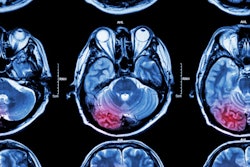
There are three key characteristics evident on CT angiography (CTA) scans that show clot-busting drugs are working to restore blood flow in stroke patients, according to a September 11 article in the Journal of the American Medical Association. These patients can thus avoid referral for surgical clot removal.
An international team of researchers, including corresponding author Dr. Andrew Demchuk from the University of Calgary in Canada, conducted the Identifying New Approaches to Optimize Thrombus Characterization for Predicting Early Recanalization and Reperfusion With IV Alteplase and Other Treatments Using Serial CT Angiography (INTERRSeCT) study.
In the multicenter, prospective trial, Demchuk and colleagues examined the CTA scans of 575 patients who presented with ischemic stroke and an intracranial clot at one of 12 centers in Canada, Spain, South Korea, Turkey, and the Czech Republic. The median age of the patients was 72 years, 51.5% were men, and their median time to baseline CTA after stroke was 114 minutes (JAMA, September 11, 2018, Vol. 320:10, pp. 1017-1026).
The patients had one of four different treatment options: 47.8% intravenously received the clot-busting drug alteplase, a type of tissue plasminogen activator (tPA); 33.9% received alteplase and underwent thrombectomy; 8.3% underwent only thrombectomy; and 9.9% received conservative treatment.
The goal was to understand how long it took for alteplase to achieve recanalization, or restore blood flow, in patients with an intracranial occlusion, the authors noted. This information, drawn from CTA scans, could help determine whether alteplase alone would be sufficient for recanalization or if patients should be transferred to a comprehensive stroke center for surgical intervention, such as with thrombectomy.
Out of the 157 patients whose CTA scans indicated successful recanalization, the vast majority of them were in the alteplase group. The difference in the proportion of patients who achieved recanalization was 17.1 percentage points greater for those who took alteplase than for those who did not.
| Recanalization in stroke patients with or without clot-busting medication | ||
| No alteplase | Alteplase | |
| Successful recanalization | 13.3% (14/105 patients) | 30.4% (143/470 patients) |
Upon further analysis, the researchers identified three factors on the CTA scans of patients who took alteplase that had a statistically significant association with the recanalization of blocked arteries (p < 0.001):
- Clots located in the distal segment of an artery (as opposed to the proximal segment)
- A residual flow grade of 2 -- i.e., high clot permeability -- based on a greater degree of contrast visible on CTA scans
- Longer time spent taking alteplase before assessment of recanalization
Patients whose clot could be characterized by one of these factors were much more likely to have early recanalization with alteplase, according to the authors. Thus, these factors could help clinicians determine the best way to triage and continue treating these patients.
"When transport times are several hours longer to a comprehensive stroke center compared with a primary stroke center, evaluation at a primary stroke center for initial treatment with intravenous alteplase is likely the better option based on reasonable recanalization rates with alteplase over several hours," they wrote.



















